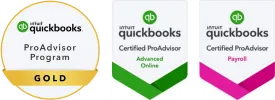Blog
Resources and Information to Help Your Business

3 Signs It’s Time to Switch to the Profit First System
3 Signs It’s Time to Switch to the Profit First System
Introduction
Running a blue-collar business is tough. You’re constantly juggling operational expenses, managing cash flow, and trying to ensure there’s enough left over to pay yourself. If you’re like most small business owners, profit often feels like an afterthought—something you hope for after covering all your bills.
But what if you flipped the script? What if, instead of hoping for profit, you made it a priority from the start? That’s exactly what the Profit First system helps you do. By reallocating how you manage your income, Profit First ensures that your business works for you, not the other way around.
In this post, we’ll cover:
What the Profit First system is
Three key signs that it’s time to implement it
How it can transform your blue-collar business
What is the Profit First System?
The Profit First system, developed by Mike Michalowicz, is a cash management framework that ensures businesses prioritize profit from day one. Instead of using the traditional formula:
Revenue – Expenses = Profit
Profit First changes the formula to:
Revenue – Profit = Expenses
The core idea is simple: Set aside your profit first, then manage your expenses with what remains. This system helps business owners break out of the cycle of living paycheck to paycheck, ensuring consistent profitability.
Profit First involves setting up dedicated bank accounts for:
Profit
Owner’s Pay
Taxes
Operating Expenses
3 Signs It’s Time to Switch to the Profit First System
1. You’re Always Playing Catch-Up
Does it feel like you’re constantly behind on bills, scrambling to find cash to cover payroll or unexpected expenses? This is one of the clearest signs that your current financial system isn’t working.
Many business owners fall into the trap of “bank balance accounting”—checking their bank balance every day to see what they can afford. The problem? This approach leaves you vulnerable to cash flow crunches and makes it hard to plan for the future.
How Profit First Helps:
Profit First forces you to prioritize profitability by setting aside a percentage of your revenue for profit first. This creates a buffer and ensures that you always have money set aside, even during lean months.
Example: A contractor who adopted Profit First saw immediate results by setting aside 5% of every deposit into a profit account. Within six months, he had enough saved to cover unexpected equipment repairs without taking on debt.
2. You Don’t Pay Yourself Consistently
Many blue-collar business owners fall into the trap of reinvesting every penny back into their business, often at the expense of paying themselves. While reinvesting is important, neglecting your own pay can lead to burnout and financial instability.
How Profit First Helps:
By creating a dedicated Owner’s Pay account, Profit First ensures that you regularly compensate yourself. This not only provides personal financial stability but also reinforces healthy business habits—you’ll learn to run your business on what remains after setting aside your pay and profit.
Pro Tip: Start small. Even setting aside 3-5% for owner’s pay can create a habit of consistent compensation.
3. You’re Unsure How Much Money is Really Yours
When personal and business finances are mixed, it’s hard to know how much of your revenue is actual profit versus what’s needed to cover upcoming expenses. This lack of clarity can lead to poor financial decisions and increased stress.
How Profit First Helps:
Profit First’s system of separate bank accounts gives you immediate clarity. By designating specific accounts for profit, taxes, and expenses, you can instantly see what’s available for each purpose.
Example: One business owner shared that after implementing Profit First, he no longer panicked during tax season because his dedicated Tax account always had enough to cover his tax bill.
How to Implement Profit First in Your Blue-Collar Business
Step 1: Open Dedicated Bank Accounts
Set up separate bank accounts for the following:
Profit – A percentage of every deposit goes here.
Owner’s Pay – This account is for your regular compensation.
Taxes – Allocate a percentage to cover your tax liabilities.
Operating Expenses – The remaining balance is what you use to run your business.
Pro Tip: If multiple accounts seem overwhelming, start with just two: a Profit account and an Operating Expenses account. You can expand as you get comfortable with the system.
Step 2: Allocate Percentages for Each Account
Initially, you may want to start with small percentages and gradually increase them as your business adapts. A common starting point is:
Profit: 5%
Owner’s Pay: 50%
Taxes: 15%
Operating Expenses: 30%
These percentages can be adjusted based on your business’s unique needs.
Step 3: Schedule Regular Allocations
Consistency is key. Schedule regular times (biweekly or monthly) to allocate your revenue into the different accounts. This helps create a rhythm and reinforces good financial habits.
Common Challenges and How to Overcome Them
Challenge 1: Cash Flow is Tight
If your business is already operating on thin margins, setting aside money may feel impossible at first.
Solution:
Start small. Even setting aside 1% for profit is better than nothing. The habit is more important than the amount—over time, you can increase the percentages as your business stabilizes.
Challenge 2: Resistance to Change
Switching to a new system can be intimidating, especially if you’re used to operating a certain way.
Solution:
Remember that Profit First is designed to help you gain control of your finances. Start with a trial period, and measure the results. Seeing the positive impact firsthand will help you stick with the system.
Challenge 3: Unexpected Expenses Disrupt the System
One of the biggest hurdles business owners face is dealing with unexpected expenses—vehicle repairs, equipment breakdowns, or emergency supplies. These unforeseen costs can throw off even the most well-planned budget, making it difficult to stick to the Profit First allocations.
Solution:
Create an Emergency Fund account within your Profit First system. Allocate a small percentage of revenue (e.g., 1-2%) to this account regularly. Over time, this fund will grow and provide a financial cushion for those unexpected expenses, so you won’t have to dip into your Profit or Owner’s Pay accounts.
Additionally, during high-revenue periods, consider temporarily increasing your contributions to the Emergency Fund to build it faster. Once it reaches a comfortable level, you can reduce or pause contributions.
Example: A general contractor used the Emergency Fund to cover a $7,000 equipment repair without disrupting his regular cash flow. This allowed him to maintain consistent profit and pay allocations, preventing long-term financial stress.
Conclusion
If you find yourself constantly struggling with cash flow, unsure of how much profit your business is really making, or unable to pay yourself consistently, it’s time to switch to the Profit First system. This simple yet powerful framework can help you take control of your finances, reduce stress, and build a more profitable, sustainable business. Click here for a bonus Profit First Checklist you can use to help you get started!
Ready to get started? Schedule a consultation today, and let’s implement a Profit First Blueprint tailored to your blue-collar business.
Partner With Us Today!
Schedule a 30 minute, no cost, no commitment consultation today. Let's see if it makes sense to work together.
DISCOVER the 10 BIGGEST Financial Mistakes Contractors Make and What You Can Do to Fix Them Today
2023 All Rights Reserved.



